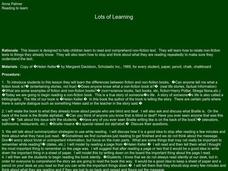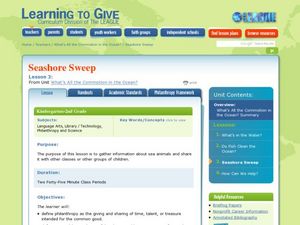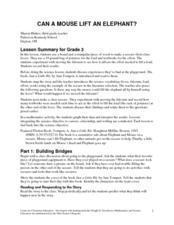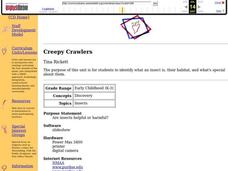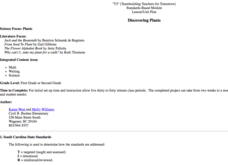Curated OER
Everybody Needs a Rock
Second graders examine science non-fiction books in the 500 section of the media center. They listen to Byrd Baylor's, Everybody Needs a Rock, and write a sentence that tells why everyone does need a rock. They illustrate the sentence.
Curated OER
Firebird
Elementary schoolers read the Firebird reading list of fantasy and complete discussion questions about fantasy. In this fantasy books lesson plan, pupils read a list of books and pick one to read.
Curated OER
Reading to Learn
Children learn to read and comprehend non-fiction text and explore how to relate non-fiction texts to things they already know. They then examine how to stop and think about what they are reading repeatedly to make sure they understand...
Curated OER
Time Travel
Students investigate the concept of time travel and quantum physics. They complete a Webquest, read excerpts from the book, 'The Time Machine,' play an online time traveler game, and read and evaluate newspaper articles about time.
Curated OER
Coral Reefs
Students examine the animals that live in a coral reef and how they adapt to their environment. In this coral lesson students write a short book on how animals inhabit the coral reefs.
Curated OER
A Seed for All Needs
Students identify uses for plants. For this agricultural lesson, students read the book Spring Gardening and distinguish between food plants and flowers. Students plant flower in cups as a follow-up activity.
Curated OER
On Market Street
Second graders study basic facts about consumers and consumer goods. The book "On Market Street" is used in this lesson.
Curated OER
Children's Literature Across the Curriculum Ideas: Chickens Aren't the Only Ones
Students read Chickens Aren't the Only Ones by Ruth Heller. They complete a variety of cross-curricular activities surrounding the study of animals that come from eggs. Included are reading, art, math, science, writing, social studies,...
Curated OER
Taking Care of Pets
Students and teacher discuss having pets such as dogs and/or cats, etc. They then read a book about pets and listen to a veterinarian visit with the them about their work and taking care of animals.
Curated OER
Seashore Sweep
Students gather information about sea animals. In this ocean lesson, students read a story about the ocean and seashore. They discuss the needs of seashore animals and create a Mystery Ocean Animal riddle book. Students also discuss...
Curated OER
Someone Like Me
Students investigate what sort of person the author is. They listen as the teacher use her notes to introduce Tom Holt briefly. Students are asked if anyone has read any of his books. They work in pairs to find more about Tom Holt as a...
Curated OER
Butterflies, Butterflies, Butterflies
Transform your class into a butterfly museum! Research different types of butterflies, their habitat, and life cycle. Interactive components such as PowerPoint presentations, Claymation movies, and webpages add pizzaz to the museum...
Curated OER
What's Out There? Space Shuttle Exploration and Simulation
Learners simulate life in space aboard the space shuttle. In this space exploration lesson plan, students work in small groups to model life aboard the space shuttle. Each student is given a job, conducts Internet research on space, and...
Washington Office of Superintendent of Public Instruction
Using Our Senses to Observe
Look around and explore. Little ones use their five senses with some day-to-day activities designed to guide observation and apply STEM strategies. Young scientists learn through comparing/contrasting and...
Curated OER
Our Dinopals with WordArt
Elementary schoolers use the writing process steps to write a descriptive paragraph about a fictional dinosaur. Using a tech tool lesson, they create a graphic title for the paragraph. A nice blending of technology with "old-fashioned"...
Curated OER
Can a Mouse Lift an Elephant?
Read Just a Little Bit, by Ann Tompert as an introduction to levers. Discuss playground seesaws and then turn learners loose to experiment with the placement of a fulcrum. Their goal is to determine where to place it in order to lift ten...
Curated OER
Colors, Colors Everywhere
Students mix red, yellow, and blue frosting together to produce secondary colors. Pupils are shown that all colors are made from mixing primary colors of paint together. They discuss the color wheel and spread the "paint" icing on...
Melissa Institute for Violence Prevention and Treatment
Concept Muraling
Concept muraling helps learners improve their comprehension of a text by giving them a way to organize their understanding of the key concepts in that text. Introduce readers to this process with a carefully scaffolded lesson that models...
Curated OER
Turtle Talk
Young scholars watch a Powerpoint Presentation about turtles. They explain that there are 3 types of turtles and where each type lives. They describe a turtle's body and state some things that turtles eat.
Curated OER
Rainforest Introduction
First graders explore world geography by completing a KWL chart. In this rainforest research lesson, 1st graders read a fictional story discussing a boy who lives in the rainforest. Students analyze the story, identify the plot and...
Curated OER
Creepy Crawlers
Students identify the characteristics of an insect and their habitat. They read books about insects, research different types of insects, and create their own insect art. The project also includes the creation of an insect song and...
Curated OER
Clustering
Fifth graders are introduced to the concept of clustering. In groups, they use their new science vocabulary words to put into a web or cluster. To end the lesson plan, they read a book related to electricity and write the definitions of...
Curated OER
Introduction to Immigration
Students read and discuss selected library resources (both fiction and non-fiction) about children and immigration. They discuss some of the historical trends that have occurred in patterns of immigration to America.
University of Southern California
Discovering Plants
Students construct a small greenhouse and plant lima beans. They read books about plants, tend the lima bean seedlings, observe and record plant growth, taste a variety of plants and maintain plant journals.


